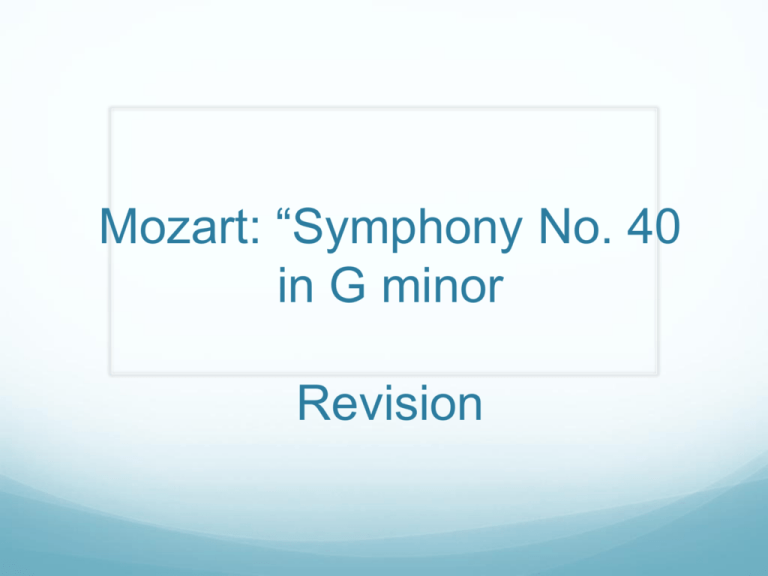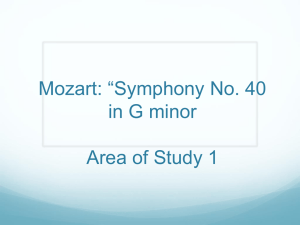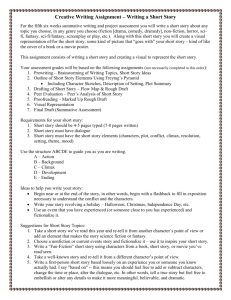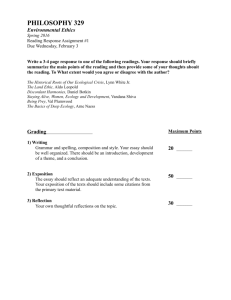Mozart: *Symphony No. 40 in G minor
advertisement

Mozart: “Symphony No. 40 in G minor Revision Learning Objective By the end of the lesson, you: Will be able to define the three sections of a Sonata Form Will be able to understand: The purpose of the Exposition How Mozart sets the mood The role of the Horns Know what happens in each section of the piece Know how to answer a Section B type question on Mozart Starter Write down the three sections in a Sonata form and explain what happens in each section 10 mins Link to L.O: By the end of the lesson you will be able to: define the three sections of a Sonata Form Exposition Two contrasting themes 1st Subject: G minor 2nd Subject: Bb major Bridge Passage Development No new ideas Recapitulation Ideas from exposition repeated Develop ideas mainly from the 1st subject but also 2nd subject Bridge passage extended Exploration of different keys not heard in exposition The coda is a further development of the 3 note from the 1st subject Avoidance of tonic/ dominant keys 2nd subject remains in tonic as piece needs to end in tonic key Codetta Section is repeated Questions relating to the Mozart 1. How does Mozart contrast his music in different ways? 2. What is the mood of the piece as a whole? 3. How does Mozart change the mood? 4. What’s the purpose of the exposition? 5. How does Mozart contrast his ideas? 6. What is the role of the horns? 7. What are the horns used for? Link to L.O: By the end of the lesson you will be able to: understand the purpose of the exposition, how Mozart sets the mood and the role of the Horns Three categories 1. The mood of the whole piece/ each section 2. The purpose of the exposition 3. The roles of the Horns Link to L.O: By the end of the lesson you will be able to: understand the purpose of the exposition, how Mozart sets the mood and the role of the Horns The mood of the whole piece/ each section 1st and 2nd subject have contrasting themes: 1st Subject: Link to L.O: By the end of the lesson you will be able to: understand the purpose of the exposition, how Mozart sets the mood and the role of the Horns The mood of the whole piece/ each section 2nd Subject Link to L.O: By the end of the lesson you will be able to: understand the purpose of the exposition, how Mozart sets the mood and the role of the Horns The mood of the whole piece/ each section The development of the 1st subject Link to L.O: By the end of the lesson you will be able to: understand the answer to my key question The mood of the whole piece/ each section Fast tempo Serious and dramatic Exciting Dramatic G minor key 1st subject being dominated by strings section 2nd subject, pathètique mood - dialogue between woodwind and strings Link to L.O: By the end of the lesson you will be able to: understand the purpose of the exposition, how Mozart sets the mood and the role of the Horns The purpose of the exposition The main purpose of the exposition is to expose the main themes The first theme: First subject Bridge Passage The second theme: Second subject Link to L.O: By the end of the lesson you will be able to: understand the purpose of the exposition, how Mozart sets the mood and the role of the Horns The purpose of the Horns In this piece the Horns reinforce musical texture at key moments for example end of sections and cadences etc Analysis Section Sub section Detail Exposition 1st Subject (bars 1-28) •G minor •No introduction •1st idea bars 1-9 •2nd idea bars 9-14 •1st 3 notes repeated motif •Sequence •Dominated by strings Bridge Passage (bars 28-43) •Modulates to the relative major (Bb) •More chromatic •Woodwind provide harmonic filling in texture •Horns enter •Descending sequence from strings 2nd Subject (bars 44-72) •Bb major •Theme shared by strings and woodwind •Swap parts from bars 44-51 & 52-58 •Mood – graceful pathetique – chromatic descent: grief & sadness •1 bar sequences •Chromatic passages Codetta (72100) •Modulates from Bb major to G minor •Based on 3 note motif •Homophonic texture (bars 88-100) •Imitation (Clarinets and Bassoons) •Canon between upper and lower strings (bars 73-88) Bars 101164 •Based on 3 note motif in 1st subject •Chromatic harmony •Woodwind provide chordal harmonic support – thickens texture •Constant exploration of keys! Development Section Recapitulation Sub section Detail 1st Subject (164-184) •G minor (exactly the same as exposition) Bridge Passage (184227) •Still in tonic key •Extended to 51 bars •Structural balance to form & extended ideas •Bass counter-melody against theme (bars 191-197) •Modulates to different keys but comes back to the tonic 2nd Subject (227-260) •Played in tonic key •Like the exposition •1 bar sequences Coda (261-299) •3 note motif passed between Woodwind •Imitation •Homophonic texture Questions In what century was this piece of music composed? What style is this piece of music written in? Comment on how Mozart uses the following musical elements in No.40 in G minor: Instruments Melody Dynamics Tonality and Harmony Form and Structure Remember to use correct musical vocabulary where appropriate Link to L.O: By the end of the lesson you will be able to: know how to answer a Section B type question on Mozart






